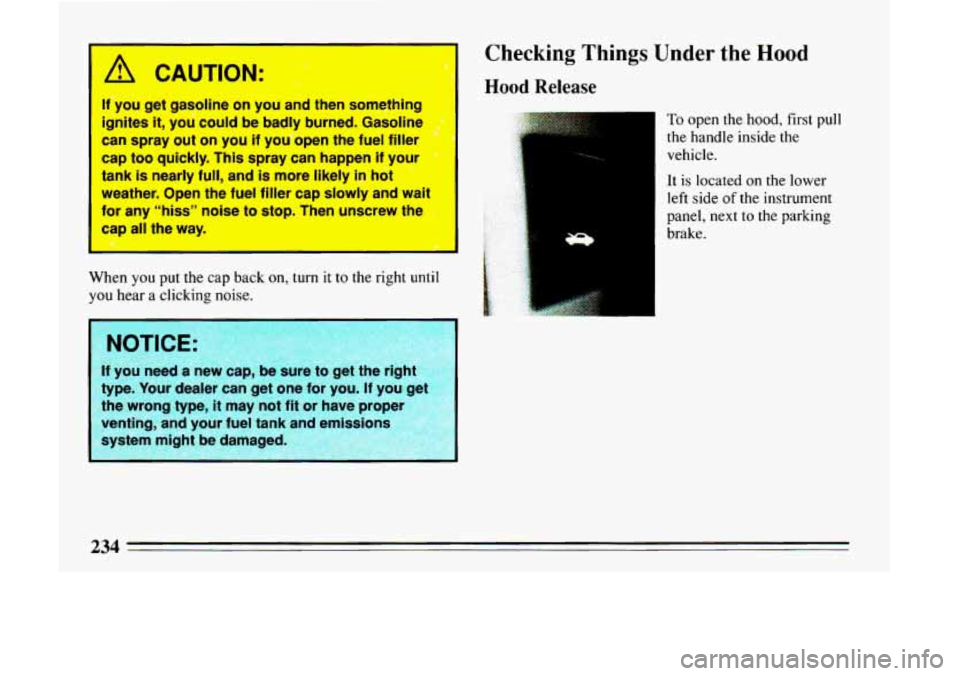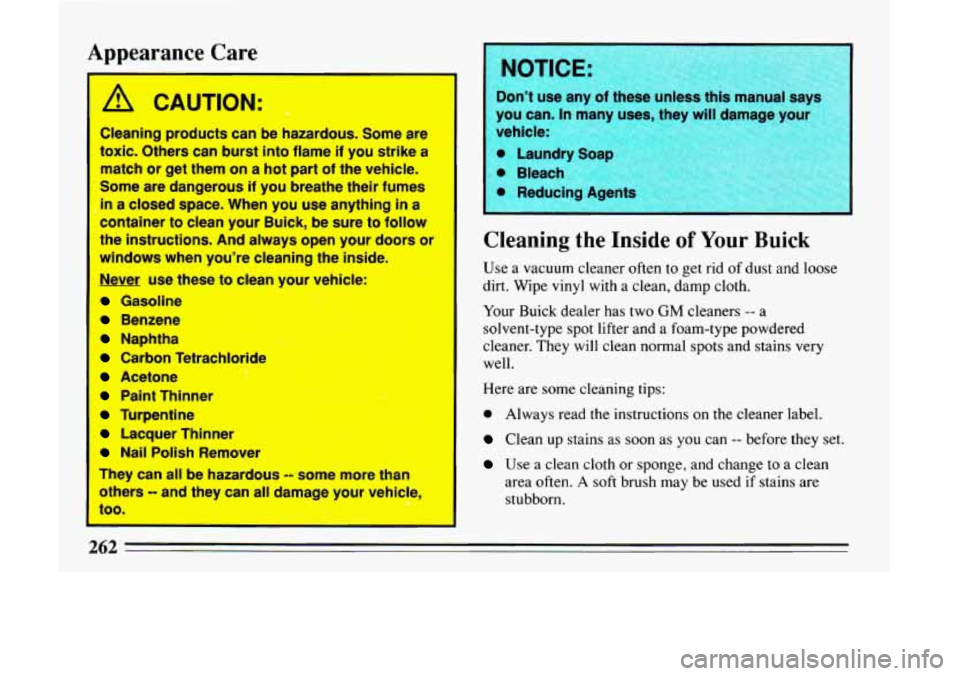1993 BUICK LESABRE gas type
[x] Cancel search: gas typePage 37 of 324

threshold level. When impacting straight into a wall that
does
not move or deform, the threshold level for most
GM vehicles is between 9 and 14 mph. However, this
velocity threshold depends
on the vehicle design and
may be several miles-per-hour faster or slower.
In
addition, this threshold velocity will be considerably
higher if the vehicle strikes an object such as a parked
car which will move and deform on impact. The air bag
is also not designed to inflate in rollovers, side impacts,
or rear impacts where the inflation would provide
no
occupant protection benefit.
In any particular crash, the determination of whether the
air bag should have inflated cannot be based solely
on
the level of damage on the vehicle(s). Inflation is
determined by the angle of the impact and the vehicle’s
deceleration,
of which vehicle damage is only one
indication. Repair cost is not a good indicator of
whether an air bag should have deployed.
What makes an air bag inflate?
In a frontal impact of sufficient severity, sensors
strategically located on the vehicle detect that the
vehicle is suddenly stopping as a result of
a crash. These
sensors complete an electrical circuit, triggering a
chemical reaction of the sodium azide sealed in the
inflator. The reaction produces nitrogen gas, which
inflates the cloth bag. The inflator, cloth bag, and related hardware
are all part
of the air bag inflator module
packed inside the steering wheel.
How does an air bag restrain?
In moderate to severe frontal or near-frontal collisions,
even belted occupants can contact the steering wheel.
The air bag supplements the protection provided by
safety belts. Air bags distribute the force of the impact
more evenly over the occupant’s upper body, stopping
the occupant more gradually. But air bags would not
provide protection in many types
of collisions, including
rollovers and rear and side impacts, primarily because
an occupant’s motion is not toward the air bag. Air bags
should never be regarded as anything more than a
supplement to safety belt protection in moderate to
severe frontal and near-frontal collisions.
What will you see after an air bag inflation?
After the air bag has inflated, it will then quickly
deflate. This occurs
so quickly that some people may
not even realize that the air bag inflated. The air bag will
not impede the driver’s vision or ability to steer the
vehicle, nor will it hinder the occupants from exiting the
vehicle. There will be small amounts
of smoke coming
from vents in the deflated air bag. Some components
of
the air bag module in the steering wheel hub may be hot
for a short time, but the portion
of the bag that comes
into contact with you will
not be hot to the touch. The
35
Page 236 of 324

A CAUTION:
If you get gasoline on you and then something
ignites
it, you could be badly burned. Gasoline
can spray out on you
if you open the fuel filler
cap too quickly. This spray can happen if your
tank
is nearly full, and is more likely in’hot
weather. Open the fuel filler cap slowly and wait
for any “hiss” noise
to stop. Then unscrew the
cap
all the way.
When you put the cap back on, turn it to the right until
you hear a clicking noise.
1
If you need a new cap, be sure to get tlie rlgnt
type. Your dealer can get one for you.
If you ge
the wrong type, it may
not fit or have propor
venting, and your fuel tank
and emissions
system might be damaged
Checking Things Under the Hood
Hood Release
To open the hood, first pull
the handle inside the
vehicle.
It is located on the lower
left side
of the instrument
panel,
next to the parking
brake.
234
.I
Page 264 of 324

Appearance Care
A CAUTION:
Cleaning products can be hazardous. Some are
toxic. Others can burst into flame if you strike a
match or get them on a hot part
of the vehicle.
Some are dangerous
if you breathe their fumes
in a closed space. When you use anything in a
container
to clean your Buick, be sure to follow
the instructions.
And always open your doors or
windows when you're cleaning the inside.
Never use these to clean your vehicle:
Gasoline
Benzene
Naphtha
Carbon Tetrachloride
Acetone
Paint Thinner 0.y
Turpentine I L'
Lacquer Thinner
Nail Polish Remover I
They can all be hazardous -- some more than
others
-- and they can all damage your vehicle,
00.
m
Cleaning the Inside of Your Buick
Use a vacuum cleaner often to get rid of dust and loose
dirt. Wipe vinyl with
a clean, damp cloth.
Your Buick dealer has two
GM cleaners -- a
solvent-type spot lifter and a foam-type powdered
cleaner. They will clean normal spots and stains very
well.
Here are
some cleaning tips:
0 Always read the instructions on the cleaner label.
Clean up stains as soon as you can -- before they set.
Use a clean cloth or sponge, and change to a clean
area often.
A soft brush may be used if stains are
stubborn.
I
262
Page 289 of 324

Inspect hoses and replace if they are cracked,
swollen or deteriorated. Tighten screw-type hose
clamps. Clean the outside
of the radiator and air
conditioning condenser. Wash the pressure cap and
neck.
8.
To help ensure proper operation, we recommend a
pressure test of both the cooling system and the
pressure cap.
7. Transaxle Service -- Change both the fluid and
filter every
15,000 miles (25 000 km) if the vehicle
is mainly driven under one or more of these
conditions:
0 In heavy city traffic where the outside
temperature regularly reaches
90 F (32 C) or
higher.
0 In hilly or mountainous terrain.
0 When doing frequent trailer towing.
0 Uses such as found in taxi, police car or delivery
service.
9.
If you do not use your vehicle under any of these
conditions, change both the fluid and filter every
100,000 miles
(140 000 km).
Spark Plug Replacement* -- Replace spark plugs
with the proper type. See "Specifications Chart" in
the Index.
Spark Plug Wire Inspection*? -- Inspect for
burns, cracks or other damage. Check the boot fit at
the distributor and at the spark plugs. Replace wires
as needed.
10. Air Cleaner Filter Replacement* -- Replace every
30,000 miles (50 000 km) or more often under dusty
conditions. Ask your dealer for the proper
replacement intervals for your driving conditions.
11. Fuel Tank, Cap and Lines Inspection"? -- Inspect
fuel tank, cap and lines (including fuel rails and
injection assembly,
if equipped) for damage or leaks.
Inspect fuel cap gasket for an even filler neck
imprint or any damage. Replace parts as needed.
Periodic replacement
of the fuel filter is not required.
* An Emission Control Service.
-t The U.S. Environmental Protection Agency has determined that the failure to perform this maintenance item will not nullify the emission warranty or limit recall liability prior to the completion of vehicle
useful life. General Motors, however, urges that all recommended maintenance services be perlormed at the indicated intervals and the maintenance be recorded in "Section E:Maintenance Record".
287